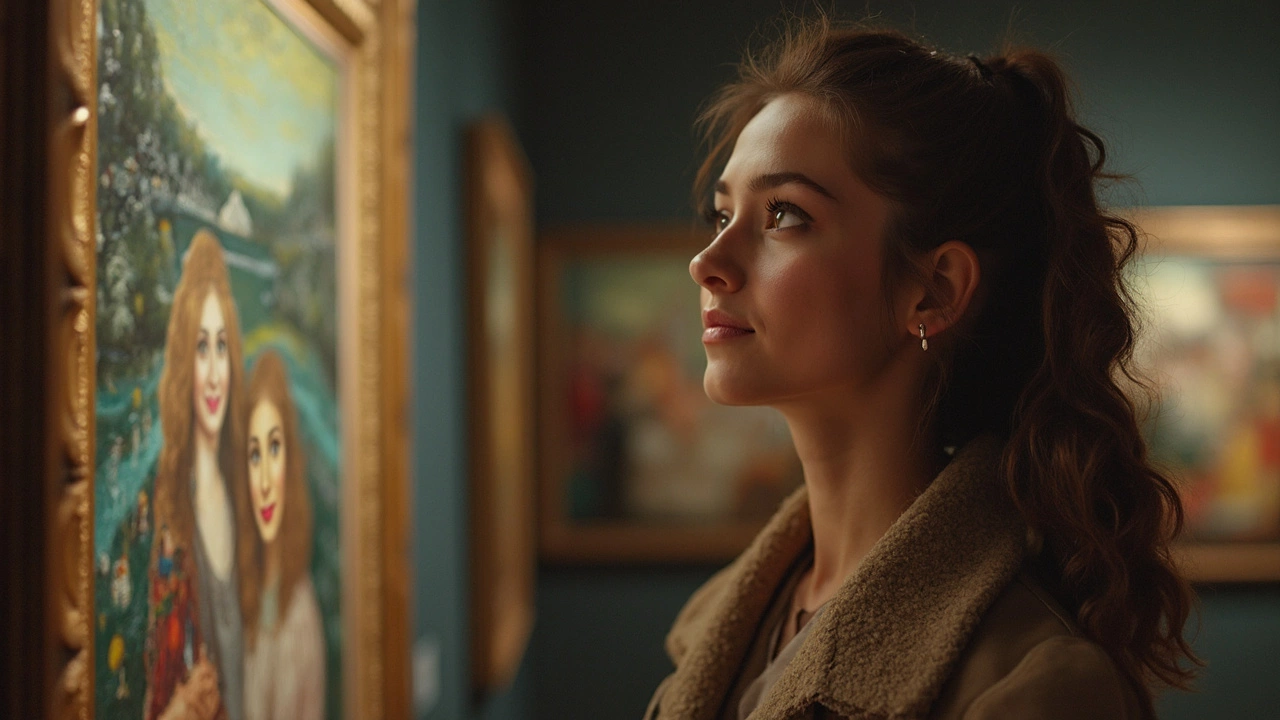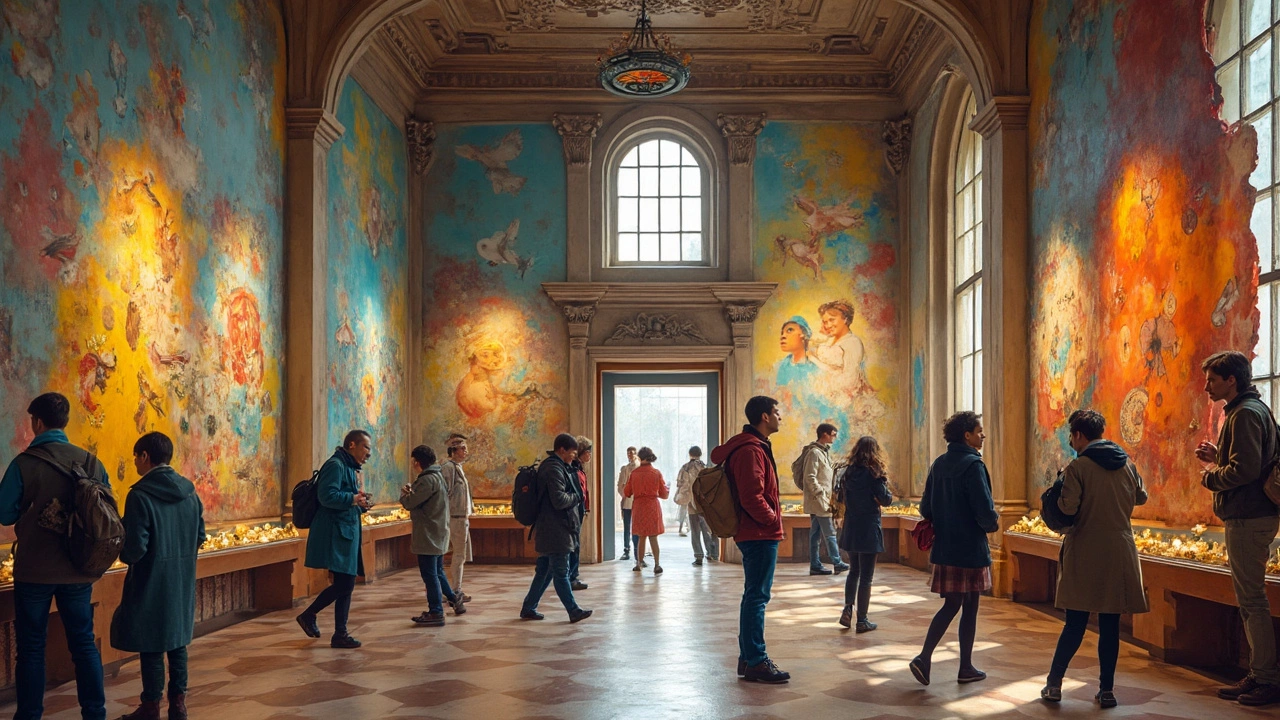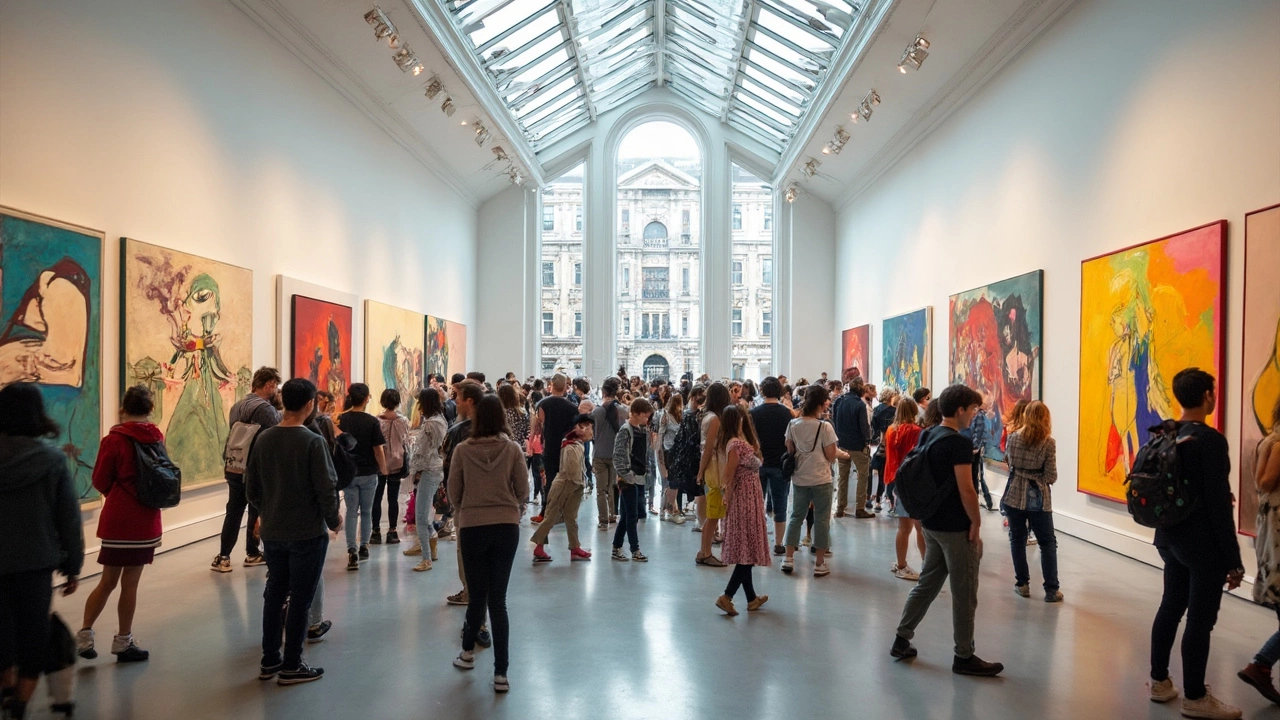Modern art isn’t about fancy gold frames or portraits looking back at you. Imagine walking into a museum and seeing a giant red square next to a pile of bicycle parts. That’s modern art in action—it shocks, questions, and flips tradition upside-down. If you’ve ever wondered why a bunch of squiggly lines or perfectly stacked cans counts as “art,” you’re not alone. It’s confusing. But once you get a handle on what’s included, it gets less weird and a whole lot more interesting.
This isn’t just about paintings with wild colors or sculptures made out of scrap metal. Modern art covers a time when artists stopped caring about old rules and started experimenting. They wanted to show feelings, big ideas, or just mess with your head. Want to know if something is modern art? Think bold, experimental, and totally different than anything you’d find in a palace or history textbook. Knowing what falls under modern art can help you spot it—and even enjoy it—next time you’re scrolling on Instagram or standing in front of something baffling at a gallery.
- Where Modern Art Begins and Ends
- Key Styles and Movements
- Famous Examples and How to Spot Them
- How Modern Art Broke the Rules
- Simple Tips for Understanding Modern Art
Where Modern Art Begins and Ends
The story of modern art doesn’t just pop up out of nowhere. It really kicks off in the late 1800s, right around when cameras showed up and artists realized painting people to look exactly like real life was kind of old news. You can blame (or thank) the Impressionists in France—think Monet’s blurry gardens or Degas’ ballet dancers—for getting the ball rolling. From there, everything sped up fast. By the early 1900s, modern art was on fire in Europe and the United States.
Modern art mostly stretches from the 1860s to about the late 1960s or early 1970s. Art after that? That’s usually called contemporary art, which deals with the ‘right now’ of the art world. People sometimes fight over these dates, but if you think ‘before the moon landing, it’s modern art,’ you’re pretty close. What happened in these years was huge: artists stopped following the rules and started getting wild with color, shapes, and crazy new ideas.
Here’s a quick view of how those dates line up:
| Period | Years | What Changed? |
|---|---|---|
| Pre-Modern | Before 1860 | Focus on realistic, classic art |
| Modern Art | 1860s–1970s | Experimenting, breaking traditions, new materials and styles |
| Contemporary Art | 1970s–today | Mixing styles, using tech, dealing with current issues |
To spot modern art, look for big experiments: weird shapes, bold colors, confusing scenes, or materials nobody would call ‘classic.’ But don’t mix it up with ‘modern’ as in ‘anything new.’ In art talk, ‘modern’ is a set window of time and style. After that, art just gets labeled ‘contemporary,’ which is a whole different rabbit hole.
Key Styles and Movements
If you want to really get what modern art is, you need to know about the huge mix of styles that made it famous. It’s not one look or idea—think of it like a playlist full of totally different songs, each changing the way people thought about art. Here’s where the action happened.
- Abstract Art – Forget perfect faces or landscapes. These artists ditched real-life stuff and used shapes, colors, and lines to say what they wanted. Wassily Kandinsky started showing his wild color blasts around 1911—he even called one piece “Composition VII,” which is just as mysterious as it sounds.
- Cubism – Pablo Picasso and Georges Braque basically broke everything into blocks and angles, almost like looking through a shattered mirror. "Les Demoiselles d’Avignon" is a Cubist classic. It made people question what real life even looks like.
- Surrealism – These artists wanted to dig into dreams and the subconscious. Think melting clocks and strange fantasy worlds—Salvador Dalí is the king of weird here. His “The Persistence of Memory” has those floppy clocks that everybody recognizes.
- Futurism – It sounds fast because it is. Artists wanted to capture movement, speed, and technology. Ever seen a painting that looks like it’s busting out of the frame? That’s probably Futurist.
- Pop Art – Jump to the 1950s and 60s, and you’ll hit Pop Art, which used images from comics, ads, and everyday life. Andy Warhol’s Campbell’s Soup cans turned grocery store goods into actual art, all while poking fun at what people buy and watch.
Modern art styles aren’t just about looks—they’re about challenging what art even means. As MoMA puts it,
“Modern artists questioned established traditions and embraced new ways of seeing and with fresh ideas about the nature of materials and functions of art.”
To picture how fast things changed, check out this rough timeline of big modern art movements:
| Movement | Years Started | Big Name Artists |
|---|---|---|
| Impressionism | 1870s | Claude Monet, Edgar Degas |
| Cubism | 1907 | Pablo Picasso, Georges Braque |
| Abstract Art | 1910-1920s | Wassily Kandinsky, Piet Mondrian |
| Surrealism | 1920s | Salvador Dalí, René Magritte |
| Pop Art | 1950s-60s | Andy Warhol, Roy Lichtenstein |
Knowing these styles makes modern art less random. Spot those bold colors, weird angles, or cartoon vibes, and you’ll know what you’re looking at—and maybe even why the artist made it that way.

Famous Examples and How to Spot Them
When people think of modern art, certain names and artworks pop up a lot. Ever heard of Picasso’s “Les Demoiselles d’Avignon” or Kandinsky’s “Composition VII”? These pieces broke every rule at the time. They tossed out lifelike bodies and perspective to focus on shapes, color, and feelings. If you see a painting that doesn’t try to copy what’s in front of us, you might just be staring at modern art.
Andy Warhol’s “Campbell’s Soup Cans” is another classic. Warhol took a grocery store icon and made it into a series of paintings. Suddenly, something boring was seen as bold and clever. Or think back to Marcel Duchamp’s “Fountain,” which is literally a urinal flipped on its back. This wasn’t just a stunt—Duchamp was asking: what is art, anyway?
If you want to quickly spot a famous example, here are a few signs:
- Unusual materials—like ready-made objects or funky textures.
- Barely any attempt at realism—look for wild shapes or even just color blobs.
- Big ideas—often the backstory is as important as what you see.
- Signatures from names you’ve heard a ton, like Matisse, Dali, or Mondrian.
Here’s a cheat sheet of famous modern works and what makes them stand out:
| Artwork | Artist | Year | What's Unique |
|---|---|---|---|
| Les Demoiselles d’Avignon | Pablo Picasso | 1907 | Shattered normal perspective; faces inspired by African masks. |
| Composition VII | Wassily Kandinsky | 1913 | Pure abstraction—no people, lots of movement. |
| The Persistence of Memory | Salvador Dalí | 1931 | Melting clocks; dreamlike, almost surreal vibe. |
| Campbell’s Soup Cans | Andy Warhol | 1962 | Everyday object turned into iconic art, all about pop culture. |
| Broadway Boogie Woogie | Piet Mondrian | 1942-43 | Grid pattern, bold colors—looks like NYC streets from above. |
| Fountain | Marcel Duchamp | 1917 | Ordinary urinal, flipped and signed; major disruption in art history. |
Warhol’s soup cans and Duchamp’s urinal might make you scratch your head, but these works changed how people talk about art. If you spot everyday stuff being turned into gallery pieces, or paintings that ditch traditional beauty for weirdness or ideas, you’re probably looking at modern art. Don’t just focus on what you see—ask what message or challenge is tucked inside. Those questions are the heart of modern art.
How Modern Art Broke the Rules
Modern art was a total gamechanger. Artists got tired of following old-school formulas and threw the whole rulebook out the window. They ditched lifelike portraits and historical scenes for wild color choices, weird shapes, and subjects that made people scratch their heads. No one was painting for kings or to record battles anymore. Now, artists painted how they felt or what they imagined—sometimes even stuff that made no sense at all.
Pablo Picasso shocked the world with Cubism around 1907 by slicing up people and objects into blocks and angles. Matisse splashed bold, unnatural colors across large canvases without worrying if faces looked green or blue. Then came Dada artists during World War I, who glued random items together or scribbled jokes on famous paintings—just to prove art didn’t have to be precious or perfect. This “anything goes” energy opened up space for real creativity and endless arguments about what art even is.
Here’s how modern artists pushed boundaries:
- They used everyday objects as art (Marcel Duchamp’s urinal, anyone?)
- Abstract art threw out realistic pictures for shapes and colors, as in Kandinsky’s wild paintings
- Collage became a thing—gluing photos, scraps, or even trash right onto their canvases
- Photography, once seen as not “real” art, got mixed into paintings or used all by itself
- Performance art: people making art live with their bodies (think: dancing, yelling, or even just standing still)
Look at these eye-opening facts from the world of modern art:
| Innovation | Artist/Year | Why It Shook Things Up |
|---|---|---|
| Cubism | Pablo Picasso, 1907 | Smashed up perspective, made everything look fractured |
| Ready-made Art | Marcel Duchamp, 1917 | Turned a urinal into art, made everyone argue over "what counts" |
| Abstract Art | Wassily Kandinsky, 1911 | Painted pure emotion with no real-world subject |
| Pop Art | Andy Warhol, 1962 | Used soup cans and celebrities, blending art with everyday culture |
| Action Painting | Jackson Pollock, late 1940s | Dripped paint on large canvases, focusing on movement itself |
What’s wild is that people hated a lot of this stuff at first. Critics bashed Monet’s “Impression, Sunrise,” saying it was unfinished and sloppy. Duchamp’s urinal? The art establishment called it nonsense. But all that rejection just made modern artists push even harder. Their rebellion set off a ripple effect, inspiring everything from comic books to digital art today.

Simple Tips for Understanding Modern Art
The first thing to know? You don’t need a degree or an art dictionary to get what’s going on with modern art. Most people feel lost the first time they see a Jackson Pollock splatter or a Mondrian grid. That’s normal. Here’s how you can make it way less intimidating and maybe even start to enjoy it.
- Modern art is about ideas, not just looks. Sometimes, the story behind the piece matters more than the paint or the marble. For example, Marcel Duchamp’s “Fountain” (literally a urinal) made people rethink what art can be.
- Look for feelings, not perfection. Artists like Edvard Munch with “The Scream” focused on raw emotion instead of making things pretty or realistic. Ask yourself what kind of mood the art gives you. That’s often the whole point.
- Read the wall text or captions. Museums know modern art confuses people, so they put helpful signs everywhere. Even a few sentences can turn nonsense into something you get.
- Spot patterns and weird materials. Modern artists love to surprise: newspaper collages, bits of old bikes, or even piles of candy are fair game. Try to figure out why they chose those objects–many times, it’s about breaking the rules or making a point about everyday life.
- There’s no wrong answer. If you don’t get it, that’s okay. Modern art is supposed to get you thinking—even if you disagree with it, you’re doing it right.
If you try these tips at a gallery or even online, you'll start seeing why modern art is more than just chaos. The best part? It’s personal. Two people can look at the same piece and have totally different reactions, and that's exactly what the artist often wanted.

